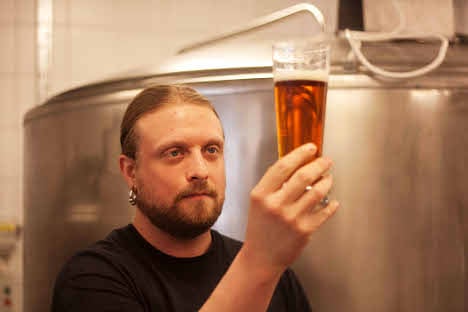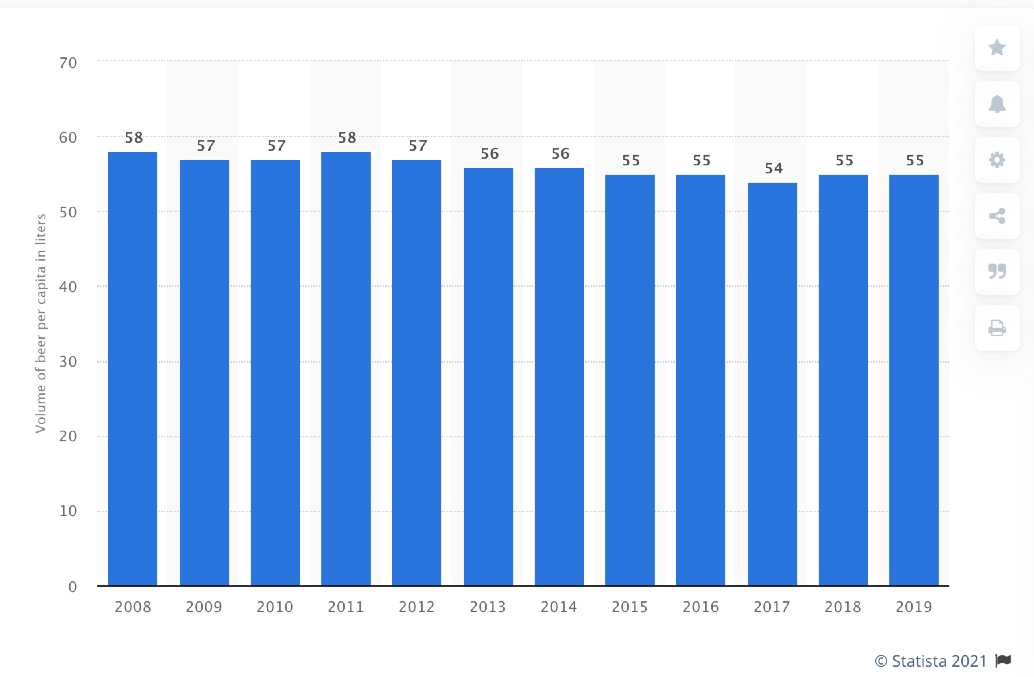See also: Guru’s guide: The best beers in Sweden right now
Since becoming the Swedish microbrewery’s first full-time employee early last year Mattias has clearly struck a chord with beer drinkers in this country, masterminding the release of a string of imaginative beers including Sigtuna Black October, Symptom of the Universe Barley Wine and Vårweizen.
As a drummer in a hard rock band, Mattias likes to play hard and fast. He applies the same high-octane level of energy to brewing his beers.
“You could say I brew in A Major, as that’s what AC/DC often play in and it’s their music I listen to when I start brewing my beers”, says Mattias.
“My brewing style is a mix of classical British and US innovation”, he adds, meaning that like US microbreweries he isn’t afraid of tearing up the brewing style rulebook now and again in his quest to find new flavours.
And Mattias isn’t alone. Sigtuna Brygghus is part of a new generation of Swedish microbreweries not afraid to take traditional beer styles and give them a contemporary kick up the backside. Breweries such as Dugges Ale & Porterbryggeri in Gothenburg, Närke Kulturbryggeri in Örebro, Nynäshamns Ångbryggeri and Oppigårds Bryggeri in Dalarna have all seen sales of their beers rocket over recent years as demand grows both at home and overseas.
Until recently Sweden was more famous for the fact nobody cared what beer they drank, as long as it was cheap and high in alcohol. Now the country is being touted as having one of the most exciting beer markets in the world.
This remarkable turnaround is largely due to brewers like Mattias and their almost fanatical belief that craft beers offer drinkers something that until recently had been largely missing in Swedish beers – real taste and character.
“All our beers at Sigtuna have a distinctive character of their own but every one is made with the emphasis on quality, complexity and taste,” says Mattias.
If brewing volumes are anything to go by this invigorated approach to brewing certainly seems to be working at the brewery located on a business park close to Stockholm’s busy Arlanda airport.
In 2008 Sigtuna Brygghus produced just 35,000 litres of beer. A year later that total had more than doubled to 100,000 litres. This year the brewery has already taken orders for more beer than they brewed in the whole of 2009, predicting to end 2010 on around 250,000 litres.
But such a meteoric rise in volumes doesn’t surprise Mattias. He believes the brewery can increase capacity to 1 million litres per year. “After that we’d have some serious space issues at the brewery,” he says with a wry smile.
To meet the surge in demand for Sigtuna’s beers the brewery now employs another full-time brewer, Emil Lindén, who Mattias describes as the “hardest working man in brewing” while the brewery owners themselves often roll up their sleeves and spend their free time helping to bottle and pack beers.
“It’s very much a team effort here at Sigtuna”, says Mattias. “When we’ve got so many orders and deadlines to meet it’s a question of everybody getting stuck in”.
Mattias’s journey from enthusiastic home brewer to a leading figure in the Swedish craft beer movement has been as fast and frenetic as his taste in music.
In 2005 he was brewing beer at home but a visit to another fledgling Swedish microbrewery Dugges Ale & Porterbryggeri in Gothenburg was to set him on his path to becoming a professional brewer. After pestering Dugges’s owner to give him work experience he quit his job as a truck mechanic (“which I hated”) and spent a year learning the brewing process from the bottom up.
He then endured a particularly frustrating four months at Swedish brewing giant Spendrups, where he described his role as “opening and closing valves and pushing buttons more than anything to do with brewing beer”.
After qualifying from a two-year brewing course run by Ludvika technical college he was invited to step up to the big league and become Sigtuna’s first Head Brewer.
A look in the fermentation room at Sigtuna reveals rows of full tanks, each labeled with the name of a beer that will shortly be launched at the Swedish monopoly alcohol stores.
While I was visiting, the brewing team were filtering 4,000 litres of East River Lager, a very drinkable, snappy US-style lager that‘s available in the Systembolaget’s ‘beställningssortiment’ (order catalogue) from the beginning of March.
Also being launched next month are not one but two Easter beers from Sigtuna. The first one, Röd Påsk is an American amber/red ale brewed with crisp US Centennial and Amarillo hops that has a strong malty backbone of chocolate and toffee. The second, Sigtuna Easter Ale, is exceptional, bursting with tropical fruit, sweet lychee and lemon flavours thanks to the addition of some generally unheard of Riwaka hops from New Zealand. Watch out for this one, as I’m already tipping it to be one of the best Swedish beers this year!
Add to this the forthcoming releases of ESB: Extra Sigtuna Bitter, described as a light bitter with malty tones and a pronounced bitter finish brewed using only British hops, Sigtuna Red Ale and Sigtuna Sommarvit, a Belgium-style wheat beer spiced with lemongrass, lime and orange and it’s obvious Mattias and the gang have their hands full.
“And we wouldn’t want it any other way”, he says, and smiles as he heads back into the brewery to turn the hard rock music back on.
See also: Guru’s guide: The best beers in Sweden right now
Darren Packman is founder of www.beersweden.se




 Please whitelist us to continue reading.
Please whitelist us to continue reading.
Member comments